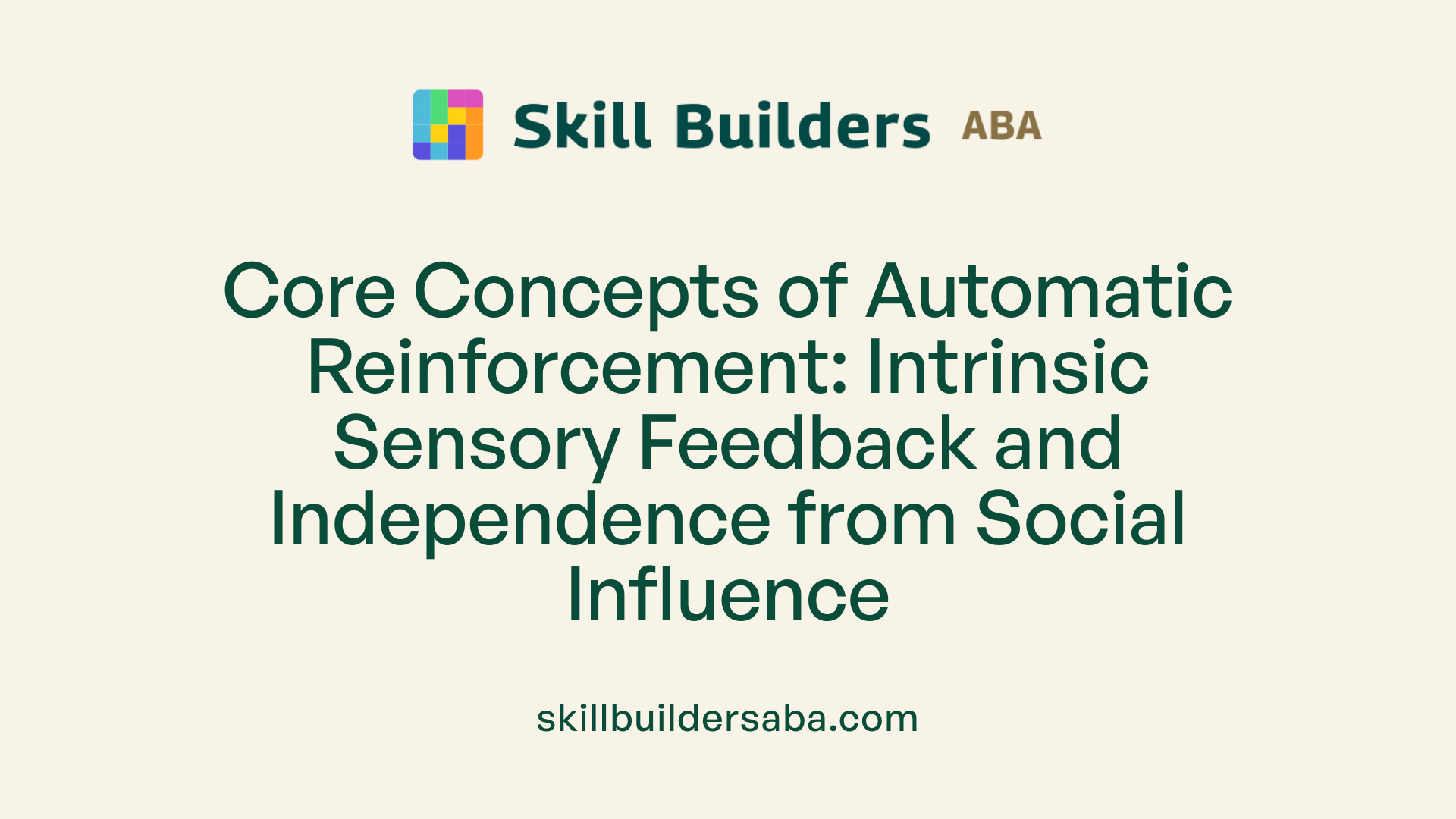What is automatic reinforcement and how is it treated
Understanding Automatic Reinforcement: Insights and Interventions

Exploring the Fundamentals of Automatic Reinforcement
Automatic reinforcement refers to the phenomenon where behaviors are maintained independently of social influence or external reinforcement. In such cases, the behavior itself delivers its own reinforcement through sensory or intrinsic effects. This article delves into the core concepts, characteristics, examples, and treatment strategies associated with automatic reinforcement, providing a comprehensive understanding of this crucial aspect of behavior analysis.
Core Concepts and Definitions of Automatic Reinforcement

What does automatic reinforcement mean?
Automatic reinforcement refers to behaviors that are maintained by operant mechanisms independent of social influence or external reinforcement from others. In these cases, the behavior itself provides its own reinforcement through sensory or intrinsic effects, making social attempts at intervention less effective.
One of the primary challenges in addressing automatically reinforced behaviors is the difficulty in identifying specific sources of reinforcement and manipulating them. Since these behaviors are not socially mediated, standard social-based interventions often do not apply. Instead, treatments tend to focus on strategies like sensory extinction, which involves reducing or eliminating the sensory feedback that reinforces the behavior, or altering establishing operations to change the likelihood of behavior occurrence.
Understanding that the behavior serves an internal reinforcing function is crucial for developing appropriate treatment strategies. This insight helps clinicians design interventions tailored to reduce or replace behaviors that are maintained by their own sensory consequences.
What are the core concepts and definitions of automatic reinforcement?
Automatic reinforcement is a form of behavior maintenance where the reinforcement is derived intrinsically from the sensory consequences produced by the behavior itself, without the need for external rewards or social interaction. This phenomenon occurs because the behavior generates sensory stimuli that are inherently pleasurable, soothing, or satisfying, thus increasing the likelihood of the behavior recurring.
There are two main categories of automatic reinforcement:
| Type | Description | Examples |
|---|---|---|
| Automatic Positive Reinforcement | Behaviors that result in the addition of pleasant stimuli, which the individual finds rewarding. | Humming because it sounds enjoyable, playing with textured objects, or engaging in self-stimulatory actions like hand-flapping that produce calming sensory feedback. |
| Automatic Negative Reinforcement | Behaviors that reduce or eliminate an undesirable or aversive stimulus. | Scratching an itch to relieve discomfort, turning off loud music to reduce noise, or rocking to decrease feelings of anxiety. |
The defining feature is that the sensory effects or outcomes are directly produced by the behavior itself, without requiring any external person or environment to provide reinforcement. This understanding emphasizes the importance of recognizing internal sensory stimuli as the primary reinforcement source.
This intrinsic reinforcement mechanism often explains behaviors like self-stimulatory actions, stereotypies, or ritualistic behaviors that persist even in the absence of social reinforcement. Recognizing these behaviors as automatically reinforced guides practitioners in developing effective treatment approaches that address their sensory or intrinsic function rather than solely focusing on social reinforcement strategies.
Characteristics and Manifestations of Automatic Reinforcement

What are the characteristics of automatic reinforcement?
Automatic reinforcement is distinguished by behaviors that are sustained by sensory feedback or internal consequences, rather than social approval or external rewards. These behaviors often occur in the absence of others, highlighting their independence from social interactions. Individuals engaging in automatically reinforced behaviors find the sensory experience inherently satisfying or soothing, which reinforces repetitive or stereotypic actions.
One of the main challenges with automatic reinforcement is identifying the specific reinforcers, as they are often internal and inaccessible for direct manipulation. This makes traditional reinforcement strategies less effective. Techniques like timeout or social restriction, which target social reinforcement, tend to be ineffective because they do not influence the sensory consequences maintaining the behavior.
In treatment, methods such as sensory extinction—reducing or blocking sensory feedback—and manipulating environmental conditions are employed. Other strategies include differential reinforcement to promote alternative behaviors and response interruption to immediately cease problematic behaviors. The success of these approaches heavily relies on the fidelity of their implementation and the specific environmental context.
Challenges and Issues in Addressing Automatic Reinforcement

What are some challenges and issues related to automatic reinforcement?
Addressing automatic reinforcement in behavior analysis involves navigating several inherent challenges. One significant difficulty lies in accurately identifying and manipulating the sources of reinforcement. Many behaviors maintained by automatic reinforcement are reinforced by sensory or intrinsic properties that are internal or difficult to observe directly. This makes pinpointing the exact stimuli responsible for maintaining the behavior complex and often uncertain.
Functional analysis, a cornerstone technique for understanding behavior functions, becomes particularly complicated when dealing with automatically reinforced behaviors. Unlike social reinforcement, which can often be managed through external interventions, the reinforcing stimuli in automatic cases are internal or inaccessible. This makes it hard to develop precise interventions based on the analysis.
Furthermore, traditional behavioral treatments typically focus on altering social or environmental contingencies. However, because behaviors maintained by automatic reinforcement are independent of external social influences, these treatments may have limited effectiveness.
Intervention approaches like response interruption, which involves physically blocking the behavior at the moment it occurs, require significant resources. To be effective, response interruption needs to be implemented immediately and consistently—a challenge outside controlled settings. Perhaps most pressing is the issue of generalization and maintaining progress. Interventions that work in a clinical setting might be difficult to sustain or replicate in everyday environments where resources, oversight, or caregiver training vary.
Overall, these factors make both the identification and treatment of automatically reinforced behaviors challenging, demanding innovative, resourceful, and individualized approaches.
Interventions and Management Strategies for Automatic Reinforcement

How is automatic reinforcement addressed in behavioral therapy?
Automatic reinforcement involves behaviors that are maintained by internal or sensory consequences, independent of social or external reinforcement. Because these behaviors are driven by internal stimuli—such as self-stimulation or sensory satisfaction—they often pose unique challenges for intervention.
In behavioral therapy, addressing automatic reinforcement requires strategies that do not solely rely on altering social environments, as the reinforcers are internal and not easily affected by social manipulation. One common approach is sensory extinction, where sensory input that sustains the behavior is reduced or eliminated. For example, providing a non-stimulatory environment or blocking sensory feedback can decrease behaviors like excessive hand-flapping or body rocking.
Manipulation of establishing operations is another tactic. This involves changing the internal or physiological conditions that motivate the behavior. For instance, providing or withholding preferred sensory items can influence the likelihood of automatic behaviors occurring.
Differential reinforcement methods are also utilized. These involve reinforcing alternative behaviors that serve the same function but are more acceptable or less disruptive. For example, teaching an individual to engage in a socially acceptable form of self-stimulation can decrease harmful stereotypies.
Punishment procedures, such as response cost or other aversive interventions, may be applied cautiously to reduce behaviors maintained by automatic reinforcement. However, these methods are generally considered when other approaches have failed, given the potential ethical and practical issues.
Response interruption techniques involve human interventions that immediately block or redirect the behavior as it occurs. While response interruption can be effective, its success strongly depends on consistent implementation and the presence of a caregiver or therapist.
Overall, interventions for automatically reinforced behaviors are complex and often involve modifying internal reinforcement sources or providing competing stimuli. Functional analysis helps identify the specific functions of behaviors, informing targeted strategies.
However, conducting functional analyses of behaviors maintained by automatic reinforcement can be difficult because the sources of reinforcement are internal and difficult to control or observe directly. This complexity explains why many treatments focus on reshaping the environment and teaching alternative behaviors.
Despite these challenges, a combination of strategies—such as non-contingent reinforcement (scheduled access to preferred items), sensory extinction, and response interruption—can reduce problematic behaviors. These strategies require careful planning and consistent application to be effective.
In summary, managing automatic reinforcement in behavioral therapy involves a nuanced approach that focuses on altering internal reinforcement mechanisms, providing alternative behaviors, and employing sensory-based interventions. While effective, these methods demand meticulous implementation and a clear understanding of the behavior’s function.
Final Thoughts on Addressing Automatic Reinforcement
Understanding automatic reinforcement is vital for effective behavior analysis and intervention. While behaviors maintained by automatic reinforcement pose significant challenges due to their intrinsic and internal nature, strategies like sensory extinction, manipulation of environmental conditions, differential reinforcement, and response interruption can be effective when applied correctly. Recognizing the internal sensory functions that sustain these behaviors is crucial for developing tailored and effective, context-specific intervention plans. Continued research and innovation in treatment approaches will further enhance our ability to support individuals exhibiting automatically reinforced behaviors, ultimately improving their quality of life.
References
- Automatic Reinforcement - ABA Therapist Jobs
- The concept of automatic reinforcement: implications for behavioral ...
- The concept of automatic reinforcement: Implications for behavioral ...
- Sensory-Automatic Reinforcement - Full Spectrum ABA
- An Approach to Identifying the Conditions Under Which Response ...
- What is Automatic Reinforcement in ABA - BehaviorPREP
- Treating Severe Behaviors Maintained by Automatic Reinforcement
.svg)














